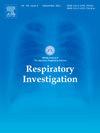Multi-modal machine learning classifier for idiopathic pulmonary fibrosis predicts mortality in interstitial lung diseases
IF 2
Q2 RESPIRATORY SYSTEM
引用次数: 0
Abstract
Background
Interstitial lung disease (ILD) prognostication incorporates clinical history, pulmonary function testing (PFTs), and chest CT pattern classifications. The machine learning classifier, Fibresolve, includes a model to help detect CT patterns associated with idiopathic pulmonary fibrosis (IPF). We developed and tested new Fibresolve software to predict outcomes in patients with ILD.
Methods
Fibresolve uses a transformer (ViT) algorithm to analyze CT imaging that additionally embeds PFTs, age, and sex to produce an overall risk score. The model was trained to optimize risk score in a dataset of 602 subjects designed to maximize predictive performance via Cox proportional hazards. Validation was completed with the first hazard ratio assessment dataset, then tested in a second datatest set.
Results
61 % of 220 subjects died in the validation set's study period, whereas 40 % of the 407 subjects died in the second dataset's. The validation dataset's mortality hazard ratio (HR) was 3.66 (95 % CI: 2.09–6.42) and 4.66 (CI: 2.47–8.77) for the moderate and high-risk groups. In the second dataset, Fibresolve was a predictor of mortality at initial visit, with a HR of 2.79 (1.73–4.49) and 5.82 (3.53–9.60) in the moderate and high-risk groups. Similar predictive performance was seen at follow-up visits, as well as with changes in the Fibresolve scores over sequential visits.
Conclusion
Fibresolve predicts mortality by automatically assessing combined CT, PFTs, age, and sex into a ViT model. The new software algorithm affords accurate prognostication and demonstrates the ability to detect clinical changes over time.
特发性肺纤维化多模态机器学习分类器预测间质性肺疾病的死亡率
背景:间质性肺疾病(ILD)的预后包括临床病史、肺功能测试(PFTs)和胸部CT类型分类。机器学习分类器Fibresolve包括一个帮助检测与特发性肺纤维化(IPF)相关的CT模式的模型。我们开发并测试了新的Fibresolve软件来预测ILD患者的预后。方法fibresolve使用变压器(ViT)算法分析CT图像,该算法还嵌入了pft、年龄和性别,以产生总体风险评分。该模型经过训练,在602个受试者的数据集中优化风险评分,旨在通过Cox比例风险最大化预测性能。用第一个风险比评估数据集完成验证,然后在第二个数据集进行测试。结果在验证集的研究期间,220名受试者中有61%死亡,而在第二个数据集的研究期间,407名受试者中有40%死亡。验证数据集的死亡率风险比(HR)为3.66 (95% CI: 2.09-6.42),中高危组为4.66 (95% CI: 2.47-8.77)。在第二个数据集中,Fibresolve是初次就诊时死亡率的预测因子,在中等和高危组中,HR为2.79(1.73-4.49)和5.82(3.53-9.60)。在随访中也观察到类似的预测性能,以及连续随访中Fibresolve评分的变化。fibresolve通过自动评估CT、PFTs、年龄和性别的ViT模型来预测死亡率。新的软件算法提供了准确的预测,并证明了检测临床变化的能力。
本文章由计算机程序翻译,如有差异,请以英文原文为准。
求助全文
约1分钟内获得全文
求助全文

 求助内容:
求助内容: 应助结果提醒方式:
应助结果提醒方式:


